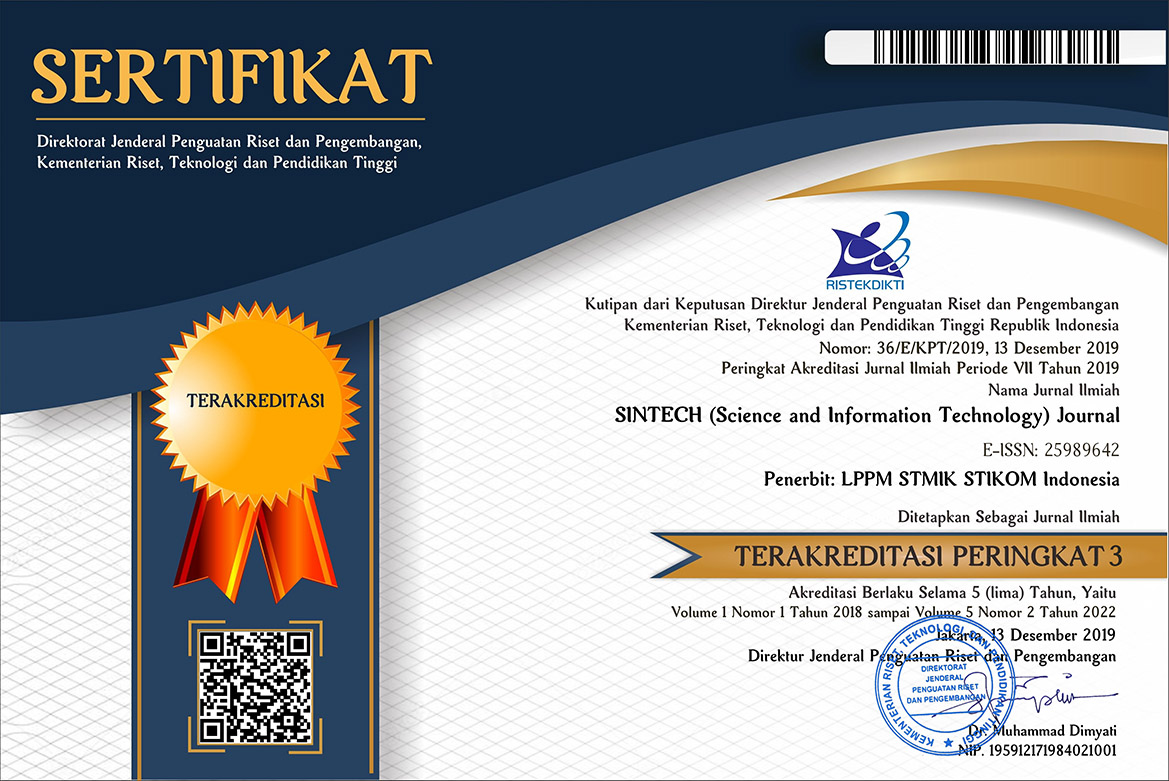UJI EFEKTIFITAS METODE FUZZY LOGIC MAMDANI PADA PENERIMAAN BEASISWA BANTUAN MENGGUNAKAN MATLAB
DOI:
https://doi.org/10.31598/sintechjournal.v5i1.1043Keywords:
Fuzzy Logic, Mamdani, The Scholarship of Higher EducationAbstract
One of the supporters in creating an even educational climate is the existence of scholarships. In general, scholarships in the form of financial assistance intended for the community of higher education, both lecturers, teachers, students and students. In the awarding of scholarships, some findings were obtained, including not being on target which caused the scholarship assistance to be ineffective. One solution in determining the acceptance of scholarships is the existence of a system that is integrated with decision-making methods. Fuzzy logic mamdani becomes one of the recommendation methods that can be implemented in decision making. So the formulation of the problem of this research is (1) How is the implementation of fuzzy logic mamdani methods to the decision-making system of receiving aid scholarships?; (2) How effective fuzzy logic methods mamdani to the decision-making system of aid scholarship. The scope of the research is (1) The method of inference with Fuzzy Logic Mamdani; (2) The tools used are Matlab version R2021b; (3) The input variable criteria consist of parental income, achievement (academic and non-academic) and average grades throughout the semester; (4) The variable output criterion is the amount of the scholarship. The final results of the study resulted in the calculation of the effectiveness of the Fuzzy Mamdanil Method of more than 50%, so that the fuzzy mamdani method can be recommended as an alternative in the decision-making method determining the amount of acceptance of aid scholarships.
Downloads
References
R. Ramadhon, R. Jaenudin, and S. Fatimah, “Pengaruh Beasiswa Terhadap Motivasi Belajar Mahasiswa Pendidikan Ekonomi Universitas Sriwijaya,” J. Profit, vol. 4, no. 2, pp. 203–213, 2017, [Online]. Available: https://media.neliti.com/media/publications/205759-pengaruh-beasiswa-dan-motivasi-belajar-t.pdf.
I. G. T. Isa, “Aplikasi Prediksi Kelulusan Tepat Waktu dengan Algoritma Naive Bayes (Studi Kasus Program Studi Teknik Informatika UMMI),” J. Santika, vol. 7, no. 2, pp. 591–599, 2017.
M. Nagamachi, “History of Kansei Engineering and Application of Artificial Intelligence,” in International Conference on Applied Human Factors and Ergonomics, 2017, no. July 2017.
C. Mohan, AN INTRODUCTION TO FUZZY SET THEORY AND FUZZY LOGIC, Second Edi., no. January. New Delhi: Viva Books - Original, 2018.
S. Sitohang and R. Denson Napitupulu, “Fuzzy Logic Untuk Menentukan Penjualan Rumah Dengan Metode Mamdani (Studi Kasus: Pt Gracia Herald),” J. ISD, vol. 2, no. 2, pp. 91–101, 2017.
S. N. Rizki, “Fuzzy logic memprediksi tingkat kecelakaan kerja pada PT.Galang Kapal di kota Batam,” Digit. Zo. J. Teknol. Inf. dan Komun., vol. 9, no. 2, pp. 151–161, 2018, doi: 10.31849/digitalzone.v9i2.1980.
S. Batubara, “Analisis Perbandingan Metode Fuzzy Mamdani Dan Fuzzy Sugeno Untuk Penentuan Kualitas Cor Beton Instan,” IT J. Res. Dev., vol. 2, no. 1, pp. 1–11, 2017, doi: 10.25299/itjrd.2017.vol2(1).644.
L. Santya, M. Miftah, V. Mandala, S. Saepudin, and D. Gustian, “Penerapan Metode Fuzzy Mamdani untuk Pendukung Keputusan Penentuan Jumlah Produksi Lantak Si Jimat,” J. Rekayasa Teknol. Nusa Putra, vol. 7, no. 1, pp. 35–41, 2019.
J. Jufriadi, G. W. Nurcahyo, and S. Sumijan, “Logika Fuzzy dengan Metode Mamdani dalam Menentukan Tingkat Peminatan Tipe Motor Honda,” J. Inform. Ekon. Bisnis, vol. 3, no. 1, pp. 7–11, 2021, doi: 10.37034/infeb.v3i1.60.
S. Nurhayati and I. Immanudin, “Penerapan Logika Fuzzy Mamdani Untuk Prediksi Pengadaan Peralatan Rumah Tangga Rumah Sakit,” Komputika J. Sist. Komput., vol. 8, no. 2, pp. 81–87, 2019, doi: 10.34010/komputika.v8i2.2254.
S. Kusumadewi and P. Hari, Aplikasi Logika Fuzzy untuk Pendukung Keputusan Edisi, Edisi Kedu. Yogyakarta: Graha Ilmu, 2013.
S. Kusumadewi, S. Hartati, A. Harjoko, and R. Wardoyo, Fuzzy multi-attribute decision making (fuzzy madm). Yogyakarta: Graha Ilmu, 2006.
I. P. Sari, “Perencanaan Jumlah Produksi Bubuk Cabai Dengan Metode Fuzzy Mamdani Berdasarkan Perkiraaan Permintaan Pada Pt Ganesha Abaditama,” J. Ilm. Teknol. dan Rekayasa, vol. 23, no. 2, pp. 133–145, 2018, doi: 10.35760/tr.2018.v23i2.2463.
I. G. T. Isa, “Perancangan aplikasi e-commerce penjualan kayu pada pt. sekar gayanti utama berbasis web,” Jasisfo (Jurnal Sist. Informasi), vol. 2, no. 1, pp. 127–140, 2021.
Downloads
Published
How to Cite
Issue
Section
License
Copyright (c) 2022 Febie Elfaladonna, Indra Griha Tofik Isa

This work is licensed under a Creative Commons Attribution-NonCommercial-ShareAlike 4.0 International License.
Copyright in each article belongs to the author.
- The authors admit that SINTECH Journal as a publisher who published the first time under
 Attribution-NonCommercial-ShareAlike 4.0 International (CC BY-NC-SA 4.0) License.
Attribution-NonCommercial-ShareAlike 4.0 International (CC BY-NC-SA 4.0) License. - Authors can include writing separately, regulate distribution of non-ekskulif of manuscripts that have been published in this journal into another version (eg sent to respository institution author, publication into a book, etc.), by recognizing that the manuscripts have been published for the first time in SINTECH Journal















1.png)




